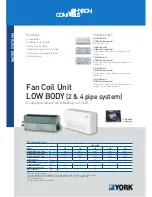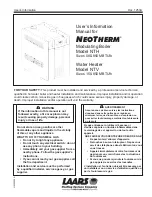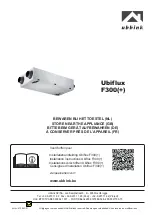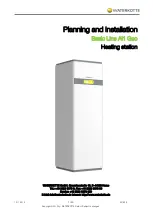
heat sources in the monitored area, eg. radiators, lamps, air
conditioning, ventilators, windows, cooking appliances, draughts.
!
The detector should look into the room, and not be aimed at windows
(see Fig. F).
!
Pets can also trigger an alarm, ensure that these cannot enter the
monitored area when the system is armed. If this is not possible, use the
motion detector 3000P2 for areas which are entered by animals when
the system is armed, as this motion detector does not react to animals
with a weight of up to 25 kg. If you use the motion detector 3000P,
install the detector upside down so that the floor area is not monitored.
In this case test that an intruder will still be detected.
!
How quickly the detector reacts is also dependent on the ambient
teperature. In a colder environment it reacts quicker.
!
Motion across the monitored area is detected much quicker than motion
directly towards the detector. Position the detector so that an intruder
will move accross the area (see Fig. D).
8.3 Door/window contact 3000M (see Fig. G, H)
!
Place the sensor on the window or door.
!
Place the magnet on the frame of the opening side of the door or window
directly adjacent to the sensor. The arrow marks must be opposite each
other and the distance between separating distance in closed condition
should not exceed 10 mm (see Fig. E).
9. Connection and commissioning
9.1 Panel 3000Z
!
Remove the cover [28] by depressing the clip [29] with a small
screwdriver or coin.
!
Insert the valid SIM card (prepaid or with contract) which you wish to use
in the panel firstly into a mobile phone and delete the PIN request.
When using a prepaid card it is advisable to use the automatic debiting
service of your provider.*
!
Slide the SIM card holder [12] to the right and lift up.
!
Place the SIM card on the contacts [15] and close the holder by sliding to
the left.
!
Connect the DC plug of the mains adapter [21] to the connector [18].
!
Connect the mains adapter with a suitable mains outlet.
!
Remove the protective foil from the front of the panel.
!
Switch the power switch [19] to the ON position. The panel is now
operational.
* The costs for SMS to the panel and the costs of SMS and calls from the
panel are according to the tarif of the provider.
Note:
#
If the GSM-signal indicator flashes once every second, the panel is trying
to establish a GSM connection (Panel cannot send or receive SMS).
#
If the GSM-signal indicator flashes onceevery two seconds, the panel is
connected to the GSM network.
#
The PIN request on the SIM card must be deleted, otherwise the panel
cannot send any SMS.
#
Insert the SIM card before activating the panel with power switch [19],
otherwise the panel cannot send any SMS.
9.2 PIR-detector 3000P2
The detector in the set is already enrolled to the siren.
!
Open the housing by pressing the clip [47] with a small screwdriver.
!
Insert two suitable alkaline 1.5 V, AA batteries into the battery
compartment [56] observing correct polarity.
!
Close the housing fully so that it clicks to. After inserting the batteries the
detector enters a 3 minutes stabilising period indicated by flashing of
the LED [43] every 3 seconds. Afterwards the detector is in operating
mode.
3 minutes after the batteries have been inserted, the LED flashes and the
detector is in operating mode. To test the detector enter the test mode by
pressing the test button [45]. You now have 3 minutes time to test the
coverage of the sensor: Hold the detector in the proposed position and then
ask somebody to walk across the monitored area. A detection will be
indicated by the LED. After up to 10 seconds deactivation the sensor is
reactivated and is ready for another detection.After 3 minutes in Test mode
the deactivation period is increased to 3-5 minutes, to save battery power
(operating mode) that means that the PIR only sends a signal to the panel
after it has not registered movement for a period of 3 to 5 minutes.
!
Set the LED/ZONE jumpers [57/58] to the desired setting (see chapter
10 - note: Remove the batteries first).
!
Secure the housing with screw [49] into screwhole [48] using a small
screwdriver.
9.3 Door/window contact 3000M
The detector in the set is already enrolled to the panel.
!
Slide the battery compartment lid downwards and lift it from the sensor
[59].
!
Set the ZONE jumper [64] to the desired setting (see Chapter 10.1).
!
Insert a suitable alkaline 1.5 V, AA battery into the battery compartment
[65] observing correct polarity.
!
Close the housing fully so that it clicks to. The detector is now in
operating mode.
!
Test the detector from the proposed position, a detection will be
indicated by the LED [60].
9.4 Remote control 3000R
The remote control in the set is already enrolled to the panel and is
operational since the battery is already installed.
10. Setting the detectors
The detectors can be set according to the position of jumpers which connect
two pins together.
Remove batteries before changing the jumper positions.
jumper connected
jumper not connected
{
39
















































